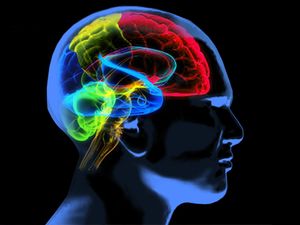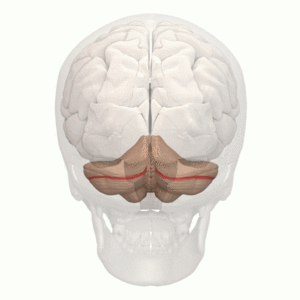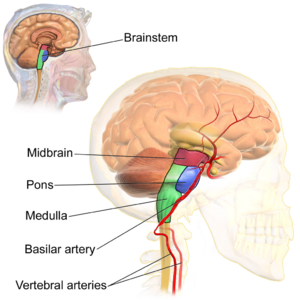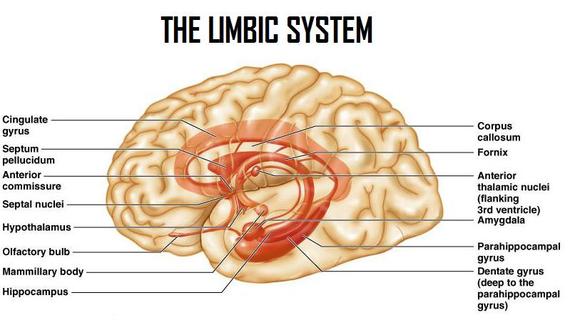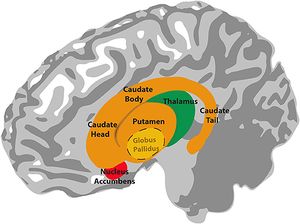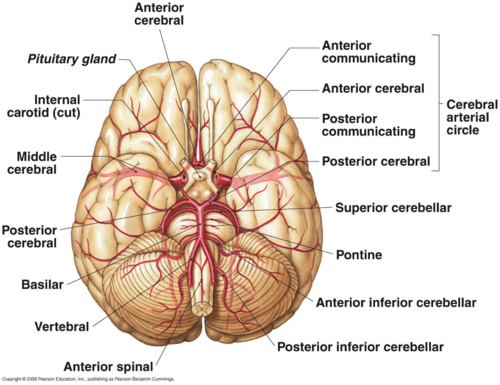Brain Anatomy
Original Editor - Naomi O'Reilly
Top Contributors - Naomi O'Reilly, Lucinda hampton, Kim Jackson, Tarina van der Stockt, Admin, Rachael Lowe, Tony Lowe, Wendy Walker, Simisola Ajeyalemi, Shaimaa Eldib, Olajumoke Ogunleye and Aminat Abolade
Introduction[edit | edit source]
The brain, contained in and protected by the skull and suspended in cerebrospinal fluid, is one of the most important and complex organs in the body. It is the central organ of the nervous system, and with the spinal cord makes up the central nervous system, which controls most of the activities of the body, processing, integrating, and coordinating the information it receives from the sense organs and determining the signals or instructions sent back to the rest of the body. [1]
At birth, the average brain weighs about 350 - 400grams, approximately 25% of the final adult brain weight of 1.4 - 1.45 kg and accounting for only 2% of overall body mass, which is reached between 10 and 15 years of age. Fastest growth occurs during the first 3 years of life, with almost 90% of the adult value reached by the age of 5 years. Its average width is about 140 mm, the average length is about 167 mm, and average height about 93 mm. While the brain continues to change throughout our life span, changes in brain morphology during childhood, adolescence and adulthood are much more subtle than those in the first 4 years of life.[2][3][4] The rate and amount of growth that occurs in the brain after birth is neither constant nor pre-determined, nor is it protected from outside influences, both positive and negative, and as such can be speeded up and increased, or slowed down and decreased. [3]
Gross Anatomy[edit | edit source]
The brain consists of three main structural divisions
- The cerebrum (outer layer is the cerebral cortex)
- The cerebellum,
- The brain stem at the base of the brain (which extends from the upper cervical spinal cord to the diencephalon of the cerebrum). [5][6]
Cerebrum[edit | edit source]
The cerebrum is the largest part of the brain. The surface of the cerebrum is composed of depressions or grooves (sulci) and ridges or raised areas (gyri), which increase the surface area of the cerebrum without an increase in the size of the brain. Grey matter, approximately 2 to 4 mm thick, forms the outer surface of the cerebrum, which processes and integrates information from white matter fibre tracts, which form the inner surface of the cerebrum. [7] The cerebrum consists of two cerebral hemispheres, the right hemisphere and the left hemisphere, connected by the corpus callosum which facilitates communication between both sides of the brain, with each hemisphere in the main connection to the contralateral side of the body i.e. the left hemisphere of the cerebrum receives information from the right side of the body resulting in motor control of the right side of the body and vice versa. The Hemispheres are then further divided into four lobes. [1][7][5]
Frontal Lobe[edit | edit source]
The frontal lobe is located at the front of the brain, occupying the area anterior to the central sulcus and superior to the lateral sulcus. It is associated with reasoning, motor skills, higher-level cognition and expressive language. At the back of the frontal lobe, near the central sulcus, lies the motor cortex. This area of the brain receives information from various lobes of the brain and utilises this information to carry out body movements. Damage to the frontal lobe can lead to changes in sexual habits, socialisation, and attention as well as increased risk-taking. [1][5][6]
| Area | Function | Dysfunction |
|---|---|---|
| Primary Motor Cortex | Voluntary Control of Movement | Altered Muscle Tone
Poor Motor Control |
| Pre Motor Area | Selection of movement based on external events | Dyspraxia |
| Supplementary Motor Area | Selection of movement based on stored plans specified by internal cues. Involved in planning of motor actions. | |
| Pre-Supplementary Motor Area | Acquiring new sequences | Dyspraxia |
| Broca's Area | Left Hemisphere - Expression of Speech | Expressive Dysphasia |
| Right Hemisphere - Non-Verbal Communication | ||
| Pre-frontal Cortex | Personality and Behaviour | Changes in Character |
| Inappropriate Behaviour | ||
| Higher executive function - problem solving, initiation, moderation and termination of bevaiour. | Dysexecutive Syndrome |
Parietal Lobe[edit | edit source]
The parietal lobe is located in the middle section of the brain, occupying an area posterior to the central sulcus and superior to the lateral sulcus, extending posteriorly as far as the parieto-occipital sulcus. It is associated with processing tactile sensory information such as pressure, touch, and pain. A portion of the brain known as the somatosensory cortex is located in this lobe and is essential to the processing of the body's senses. [1][5][6]
| Area | Function | Dysfunction |
|---|---|---|
| Primary Somatosensory Cortex | Receives Sensory Information from Whole Body | Altered Sensation |
| Homunculus Representation | ||
| Sensory Association Area | Integrates Sensory Information based on sensory inputs | |
|
Left Hemisphere - Attention to Right Side Only | Inability to Perceive and Attend to Objects, Space or Own Body despite vision, somatosensation and motor ability being intact. |
| Right Hemisphere - Attention to both Left and Right | ||
| Contralateral Neglect | ||
|
Processing of Visual Information for perception of motor and spatial relationships | Visuospatial Dysfnction |
Temporal Lobe[edit | edit source]
The temporal lobe is located on the bottom section of the brain, occupying the area inferior to the lateral sulcus. This lobe is also the location of the primary auditory cortex, which is important for interpreting sounds and the language we hear. The hippocampus is also located in the temporal lobe, which is why this portion of the brain is also heavily associated with the formation of memories. Damage to the temporal lobe can lead to problems with memory, speech perception, and language skills. [1][5][6]
| Area | Function | Dysfunction |
|---|---|---|
| Primary Auditory Cortex | Loudness | Deafness |
| Pitch | ||
| Localisation of Basic Sound | ||
| Temporal Association Areas: | Recognition and Identification fo Stimuli | Agnosia - Acknowledge the existence of a stimulus but unable to recognize what it is |
|
Face and Object Recognition | Prosopagnosia |
|
Processing Complex Sound | |
|
Recognize Spoken Word | Receptive Dysphasia |
| Interpret the meaning of Speech | ||
|
Process Visual Information related to form recognition and object representation | Visuoperceptual Dysfuncton |
| Linked to the storage of Long Term Memory | ||
| Pyriform Cortex | Processing Olfactory Sensations | Olfactory Dysfunction |
| Insula Cortex | Process Taste Sensation | Taste Dysfunction |
Occipital Lobe[edit | edit source]
The occipital lobe is located at the back portion of the brain, occupying the small area behind the parietal-occipital sulcus. It is associated with interpreting visual stimuli and information. The primary visual cortex, which receives and interprets information from the retinas of the eyes, is located in the occipital lobe. Damage to this lobe can cause visual problems such as difficulty recognizing objects, an inability to identify colors, and trouble recognizing words. [1][5][6]
| Area | Function | Dysfunction |
|---|---|---|
| Primary Visual Cortex | Determines basic attributes of Vision
|
Diplopia (Double Vision) |
| Blindness | ||
| Visual Association Area | Respond to Visual Stimuli within Receptive Fields
Modulated by Attention & Working Memory |
Cerebellum[edit | edit source]
The cerebellum, sometimes referred to as the "Little Brain", is found inferior to the tentorium cerebella or tentorial membrane in the posterior cranial fossa, posterior to the fourth ventricle, the pons and the medulla oblongata. The cerebellum accounts for approximately 10 % of the brain's total size but has for more than 50 % of the total number of neurones located in the entire brain. It is the largest part of the hindbrain forming the Deep Cerebellar Nuclei, which consists of an outer layer cortical region with an inner subcortical mass of cells. It consists of two cerebellar hemispheres joined by a narrow median vermis and is connected to the posterior aspect of the brainstem by 3 cerebellar peduncles, which are symmetrical bundles of nerve fibres. The cerebellum is divided into three small lobes; anterior, middle and flocculonodular lobes, which receive information from the balance system of the inner ear, sensory nerves, and the auditory and visual systems. [1][6]
The cerebellum is primarily involved in the coordination of movements as well as the learning of movements (motor learning) and has ipsilateral control of movement i.e. the left hemisphere of the cerebellum controls the left side of the body and vice versa. It regulates initiation, timing, sequencing, and force generation of muscle contractions, sequencing the order of muscle firing when a group of muscles work together to perform a movement and assists with balance and posture maintenance. While the cerebellum is associated with motor movement and control, motor commands do not originate here, rather the cerebellum serves to modify these motor commands it receives from sensory systems of the spinal cord and from other parts of the brain, and integrates these inputs to fine-tune motor activity in order to make motor movements accurate and useful. The cerebellum compares the intended movement originating from the motor cortex areas with the actual movement relayed back by the afferent systems and interneurons in the spinal cord. The main functions of the cerebellum are to; [1][5]
- To act as a comparator: comparing descending supraspinal signals with ascending afferent feedback. If there is any discrepancy, this is then fine-tuned to produce the actual movement desired via descending pathways. This helps to achieve smoothness and accuracy in movement.
- To act as a timing device: it converts descending motor signals into a sequence of motor activation. This helps the movement achieve smoothness and coordination, maintaining posture and balance. (receiving input from the vestibular system).
- To initiate and store movement: has the ability to store and update motor information. there is a significant role played inaccurate learned movement. This is due to a modifiable synapse at the purkinje cell.
Cerebellar damage produces disorders in fine movement, equilibrium, posture, and motor learning depending on the part of the cerebellum involved and how it is damaged. Dysfunction may result in; Hypotonia (reduced muscle tone), Ataxia, Dysarthria (the inability to articulate words properly), Nystagmus (rapid jerky eye movements) and Palatal Tremor / Myoclunus (tremor of the palate) [5][6]
Watch this 10 minute video on the Cerebellum
Brainstem[edit | edit source]
The brainstem evolutionarily is the most ancient part of the brain beginning at the foramen magnum occupying the posterior cranial fossa of the skull and is divided into three regions; the medulla oblongata, the pons and the midbrain. It connects the narrow spinal cord with the forebrain. [1][5][6]
Watch this 15 minute video on the brainstem.
Medulla Oblongata: Located directly above the spinal cord at the level of the foramen magnum forming the base of the brain stem, and connecting the pons superiorly to the spinal cord inferiorly. The medulla oblongata is oblong in shape, approximately 3cm long with the descending tracts passing through it from two pyramids on the ventral surface of the medulla between the anterior median fissure, which is disrupted where the tracts cross the midline at the decussation of the pyramids. Cranial Nerves IX (Glossopharyngeal), X (Vagus), XI (Accessory) and XII (Hypoglossal) emerge form the Medulla Oblongata. [1][5][6] The Medulla Oblongata controls many vital autonomic functions such as heart rate, breathing, and blood pressure, with the following three main functions;
- to serve as a conduit for the ascending and descending tracts to connect the spinal cord to the higher centers in the forebrain,
- to contains reflex centres associated with control of respiration, the cardiovascular system and consciousness,
- to contains nuclei of Cranial Nerves III and XII.
Pons: Located anterior to the cerebellum, the Pons connects the medulla oblongata to the midbrain. It is approximately 2.5cm long, composed of transverse fibres forming a ridge or bridge across the anterior surface area connecting the right and left cerebellar hemispheres, from which the pons gets its name. These fibres are the pontocerebellar fibers that are in turn projections from the corticopontine fibers. They cross to enter the contralateral middle cerebellar peduncle and thus enter the cerebellum. Cranial Nerves V (Trigeminal), VI (Abducens), VII (Facial) and VIII (Vestibulocochlear) emerge from the pons. [1][5][6] The Pons serves a number of important functions including playing a role in several autonomic functions including stimulation of breathing and controlling sleep cycles.
Midbrain: Extending from the Pons to the Mamillary Body, the midbrain also termed the mesencephalon is the superior most aspect of the brainstem and considered the smallest region of the brain. The substantia nigra is closely associated with motor system pathways of the basal ganglia producing Dopamine which plays a role in the movement, movement planning, excitation, motivation. Cranial Nerves II (Optic), III (Oculomotor) and IV (Trochlear) emerge form the midbrain. The midbrain is associated with vision, hearing, motor control, sleep/wake, arousal (alertness), and temperature regulation, acting as a sort of relay station for auditory and visual information. It contains the following: [1][5][6]
- Nuclei for 10 of 12 Pairs of Cranial Nerves (All except the Olfactory and Optic Nerves)
- Apparatus for Controlling Eye Movements (Cranial Nerves III, IV and VI )
- Monoaminergic Nuclei that project widely in the CNS
- Vital Respiration and Cardiovascular Centres
- Autonomic Centres
- Areas important for Consciousness
- Ascending and Descending Pathways, linking Brain to the Spinal Cord
Diencephalon[edit | edit source]
The diencephalon can be found just above the brainstem between the cerebral hemispheres. Although it is a relatively small part of the central nervous system in terms of mass, the diencephalon has a number of critical roles in healthy brain and bodily function. It contains a collection of structures with differing functions, all complex. The following is a brief summary of its contents.[9] [1]
Thalamus[edit | edit source]
The thalamus consist of two oval collections of nuclei that make up most of the mass of the diencephalon. The thalamus is often described as a relay station because almost all sensory information (with the exception of smell) that proceeds to the cortex first stops in the thalamus before being sent on to its destination. It is hypothesised that the thalamus serves a gating function in filtering information. The thalamus also plays an important role in regulating states of sleep and wakefulness [5][6]
Epithalamus[edit | edit source]
The epithalamus consists primarily of the pineal gland and the habenulae.
- The pineal gland is an endocrine gland that secretes the hormone melatonin, which is thought to play an important role in the regulation of circadian rhythms.
- The habenulae (more often referred to with the singular: habenula) are two small areas near the pineal gland. The functions of the habenula are poorly understood, but it is thought to potentially be involved with reward processing and has been implicated in depression. [9]
The function of the epithalamus is to connect the limbic system to other parts of the brain. Some functions of its components include the secretion of melatonin and secretion of hormones from the pituitary gland by the pineal gland circadian rhythms), and regulation of motor pathways and emotions. [5][6]
Hypothalamus[edit | edit source]
The hypothalamus is a small (about the size of an almond) region located directly above the brainstem. It also is made up of a collection of nuclei that are involved in a variety of functions. It receives a large input from limbic structures[9].
- It has a significantly large efferent output to the ANS and has a highly significant role in the control of pituitary endocrine function. [5][6]
- The hypothalamus as well as inputting the ANS also has a large part to play in the homeostasis of many physiological systems such as hunger, thirst, water and sodium balance and temperature regulation.
- It also plays a role in memory and emotional responses, providing autonomic and endocrine responses. It also plays a role in the control of circadian rhythms via retinal input to suprachiasmatic nucleus. There may also be hypothalamus input into sexual and emotional behaviour independent of its endocrine role. [5]
Subthalamus[edit | edit source]
- A portion of the subthalamus is made up of tissue from the midbrain extending into the diencephalon, hence parts of midbrain regions eg substantia nigra and red nucleus are found in the diencephalon.
- Also contains the subthalamic nucleus (densely interconnected with the basal ganglia) and the zona incerta (many connections throughout the cortex and spinal cord)
- Several collections of important fibers (e.g. somatosensory fibers) also pass through the subthalamus.[9]
Limbic System[edit | edit source]
The limbic system is not defined by strict anatomic boundaries but incorporates several important structures. The limbic structures conventionally include the amygdala, the hippocampus, the fornix, the mammillary bodies, the cingulate gyrus, and the parahippocampal gyrus, which lie mainly on the medial side of the temporal lobe. These structures form connections between the limbic system and the hypothalamus, thalamus and cerebral cortex. [1][6]
The limbic system has been traditionally associated with our emotional behaviour. The hippocampus is important in memory and learning, while the limbic system itself is central in the control of emotional responses and provides high-level processing of sensory information. The main outflow of the limbic system is to the prefrontal cortex and the hypothalamus as well as to cortical areas. It appears to have a role in attaching behavioural significance and response to a given stimulus. Damage to this area has profound effects on emotional responses. [1][5][6]
While a full understanding of the limbic system is far from complete, advances in neurosciences have still given a better understanding of the role the individual components of the limbic system play, and some insight into their many connections.[10]Watch this 10 minute video titled Hypothalamus and Limbic System
Basal Ganglia[edit | edit source]
The basal ganglia are a group of large nuclei, which consist of the Neostratum (Caudate and Putamen), Internal and External segments of Globus Pallidus, the Pars Reticulata, the subthalamic nucleus and the compacta of Substantia Nigra, that partially surround the thalamus, which is important in the control of movement. The red nucleus and substantia nigra of the midbrain have connections with the basal ganglia.[6]
The basal ganglia are closely integrated with the motor cortex, premotor cortex, and motor nuclei of the thalamus and play a crucial role in modulation of movements. The Neostratum is the main area of signal reception for the basal ganglia and receives information from the whole cortex in a somatotopic fashion. It relays signals to the thalamus, which projects to the premotor cortex, supplementary motor cortex and prefrontal cortex. There is also a projection to the brainstem (pedunclopontine nucleus- involved in locomotion, and superior colliculus - eye movement). [1][5]
Watch this 15 minute video on the basal ganglia.
Cranial Nerves[edit | edit source]
There are 12 pairs of cranial nerves, numbered according to the position where they originate in the inferior surface of the brain, that function mainly to convey motor signals to and sensory information from the head and neck. The lower cranial nerves have somewhat more complex visceral functions that are not strictly limited to the head and neck. The names of the Cranial Nerves (CN) are: [1][5][6]
- CN I Olfactory
- CN II Optic
- CN III Oculomotor
- CN IV Trochlear
- CN V Trigeminal
- CN VI Abducens
- CN VII Facial
- CN VIII Vestibulocochlear
- CN IX Glossopharyngeal
- CN X Vagus
- CN XI Accessory
- CN XII Hypoglossal
Ventricles and Cerebrospinal Fluid[edit | edit source]
The ventricles are a system of cavities/space within the cerebral hemispheres, which produce and circulate cerebrospinal fluid, which is continuously produced and absorbed. The cerebrospinal fluid is produced, at a rate of about 450 mL/day, by the choroid plexuses within the lateral ventricles, and circulates through the ventricular system ultimately entering the subarachnoid space, which surrounds the cerebrum, cerebellum, brain stem and spinal cord down to the level of the second sacral vertebrae. At any given time there is approximately 150 mL of cerebrospinal fluid, thus, the volume of CSF in most adults is turned over about 3 times per day. [1][6]
The brain has 4 ventricles, which is a series of interconnected spaces in the core of the brain. The lateral ventricles are within the cerebral hemispheres, which are connected to each other and to the third ventricle through a pathway called the Interventricular Foramen of Monro. The third ventricle lies in the midline, separating deeper brain structures such as the left and right thalami. The third ventricle communicates with the fourth ventricle through the Cerebral Aqueduct of Sylvius, which is a long narrow tube. [1][5]
Blood Supply[edit | edit source]
An adequate supply of oxygen and nutrients is vital for the normal function of the brain, which is achieved through a dense network of blood vessels. Arterial blood supply to the brain comes from four vessels the right and left Internal Carotid and the right and left Vertebral Arteries, which join at the base of the brain to form the basilar artery. The Anterior Circulation is composed of the carotid arteries and their branches, while the Posterior Circulation is composed of the Vertobrobasilar arteries. [1][5][6]
Watch these 15 minute videos on the blood supply of the brain.
| [11] | [12] |
Internal Carotid Arteries[edit | edit source]
Traverse the skull within the carotid canal and cavernous sinus. They then pierce the dura and enter the middle cranial fossa lateral to the optic chiasm. They then divide to supply the anterior and middle sections of the cerebral hemispheres, anterior and middle cerebral arteries. The internal carotid artery on each side terminates into the anterior cerebral artery, the middle cerebral artery, and the posterior communicating artery.[5]
Vertebral Arteries[edit | edit source]
Arising from the sub-clavian artery these two arteries enter the skull through foramen magnum after passing through foramina in the transverse processes of the upper cervical vertebra. They unite in the brainstem to form the basilar artery which ascends to form the two posterior cerebral arteries at the superior border of the Pons. This is the posterior cerebral hemisphere blood supply. This network is termed the posterior circulation. On its journey to becoming the basilar artery, the vertebral arteries give off a number of branches, including the posterior spinal artery, posterior inferior cerebral artery and the anterior spinal artery. These constitute the blood supply to the upper cervical cord. The posterior inferior cerebral artery supplies the lateral medulla and cerebellum. Damage to these blood vessels can result in motor loss or sensory loss. [5][6]
Basilar Artery[edit | edit source]
Formed by the two vertebral arteries. This has a number of branches: anterior and inferior cerebellar artery, artery to the labyrinth, pontine branches and superior cerebellar artery which supply the brain stem and cerebellum. [5]
Anterior Cerebral Arteries[edit | edit source]
The anterior cerebral artery arises from the internal carotid, at the medial extremity of the lateral cerebral fissure. It passes forward and medialward across the anterior perforated substance, above the optic nerve, to the commencement of longitudinal fissure. Is one of a pair of arteries on the brain that supplies oxygenated blood to most midline portions of the frontal lobes and superior medial parietal lobes. [5][6]
Middle Cerebral Arteries[edit | edit source]
These supply parts of the frontal, temporal, occipital and parietal lobes bilaterally, with branches also supplying the basal ganglia and posterior limb of the internal capsule.
Posterior Cerebral Arteries[edit | edit source]
These supply blood to the posterior parietal cortex, occipital lobe and inferior temporal lobe. There are several branches of this artery that supply the midbrain, thalamus, subthalamus, posterior internal capsule, optic radiation and cerebral peduncle.
Circle of Willis[edit | edit source]
The basilar artery, the posterior cerebral arteries, the posterior communicating arteries, and the anterior cerebral arteries, along with the anterior communication artery, form an important collateral circulation, the Anterior and Posterior Circulation anastomose at the base of the brain, termed the Circle of Willis. These vessels lie within the subarachnoid space and are a common location for cerebral aneurysms to form. [5][6]
Watch this 10 minute video on the circle of Willis.
Venous Drainage[edit | edit source]
The venous circulation of the brain is very different from that of the rest of the body. Usually arteries and veins run together as they supply and drain specific areas of the body, however, this is not the case in the brain. The major vein collectors are integrated into the dura to form venous sinuses, which are adjacent to the posterior cranial fossa. The venous sinuses collect the blood from the brain and pass it to the internal jugular veins. The superior and inferior sagittal sinuses drain the cerebrum, the cavernous sinuses drains the anterior skull base. All sinuses eventually drain to the sigmoid sinuses, which exit the skull and form the jugular veins. These two jugular veins are essentially the only drainage of the brain. If occlusion of either of these venous systems then raised intracranial pressure can develop. [1][5][6]
Viewing[edit | edit source]
Watch these videos for a more in-depth look parts of the brain (18 minutes).
References[edit | edit source]
- ↑ 1.00 1.01 1.02 1.03 1.04 1.05 1.06 1.07 1.08 1.09 1.10 1.11 1.12 1.13 1.14 1.15 1.16 1.17 1.18 1.19 1.20 Moore KL, Agur AM, Dalley AF, Moore KL. Essential clinical anatomy. Wolters Kluwer Health,; 2015.
- ↑ Dekaban AS, Sadowsky D. Changes in brain weights during the span of human life: relation of brain weights to body heights and body weights. Annals of Neurology: Official Journal of the American Neurological Association and the Child Neurology Society. 1978 Oct;4(4):345-56.
- ↑ 3.0 3.1 Holmes GL, Milh MM, Dulac O. Maturation of the human brain and epilepsy. InHandbook of clinical neurology 2012 Jan 1 (Vol. 107, pp. 135-143). Elsevier.
- ↑ Hartmann P, Ramseier A, Gudat F, Mihatsch MJ, Polasek W. Normal weight of the brain in adults in relation to age, sex, body height and weight. Der Pathologe. 1994 Jun;15(3):165-70.
- ↑ 5.00 5.01 5.02 5.03 5.04 5.05 5.06 5.07 5.08 5.09 5.10 5.11 5.12 5.13 5.14 5.15 5.16 5.17 5.18 5.19 5.20 5.21 5.22 5.23 5.24 5.25 5.26 Snell RS. Clinical neuroanatomy. Lippincott Williams & Wilkins; 2010.
- ↑ 6.00 6.01 6.02 6.03 6.04 6.05 6.06 6.07 6.08 6.09 6.10 6.11 6.12 6.13 6.14 6.15 6.16 6.17 6.18 6.19 6.20 6.21 6.22 6.23 Jones, K. Neurological Assessment A Clinicians Guide. Churchill Livingstone Elseiver, 2011.
- ↑ 7.0 7.1 FitzGerald MJT, Gruener G, Mtui E: Clinical neuroanatomy and neuroscience, St Louis, 2012, Elsevier, pp 78, 97–110, 299.
- ↑ UBC Medicine - Educational Media. The Cerebellum - UBC Neuroanatomy - Season 1 - Ep 8. Available from: https://youtu.be/17mxfO9nklQ[last accessed 30/08/19]
- ↑ 9.0 9.1 9.2 9.3 Neuroscienrifically challenged Diencephalon Available:https://neuroscientificallychallenged.com/posts/know-your-brain-diencephalon (accessed 30.4.2022)
- ↑ Torrico TJ, Abdijadid S. Neuroanatomy, Limbic System. InStatPearls [Internet] 2019 Feb 10. StatPearls Publishing.Available from: https://www.ncbi.nlm.nih.gov/books/NBK538491/ (last accessed 11.10.2019)
- ↑ khanacademymedicine. Cerebral blood supply - Part 1. Available from: http://www.youtube.com/watch?v=hfG8J_X1D5Q [last accessed 29/08/16]
- ↑ khanacademymedicine. Cerebral blood supply - Part 2. Available from: http://www.youtube.com/watch?v=kVulo3qDcUo [last accessed 29/08/16]
- ↑ AnatomyZone. Circle of Willis - 3D Anatomy Tutorial. Available from: http://www.youtube.com/watch?v=9hhfM7rQHiM[last accessed 30/10/17]
